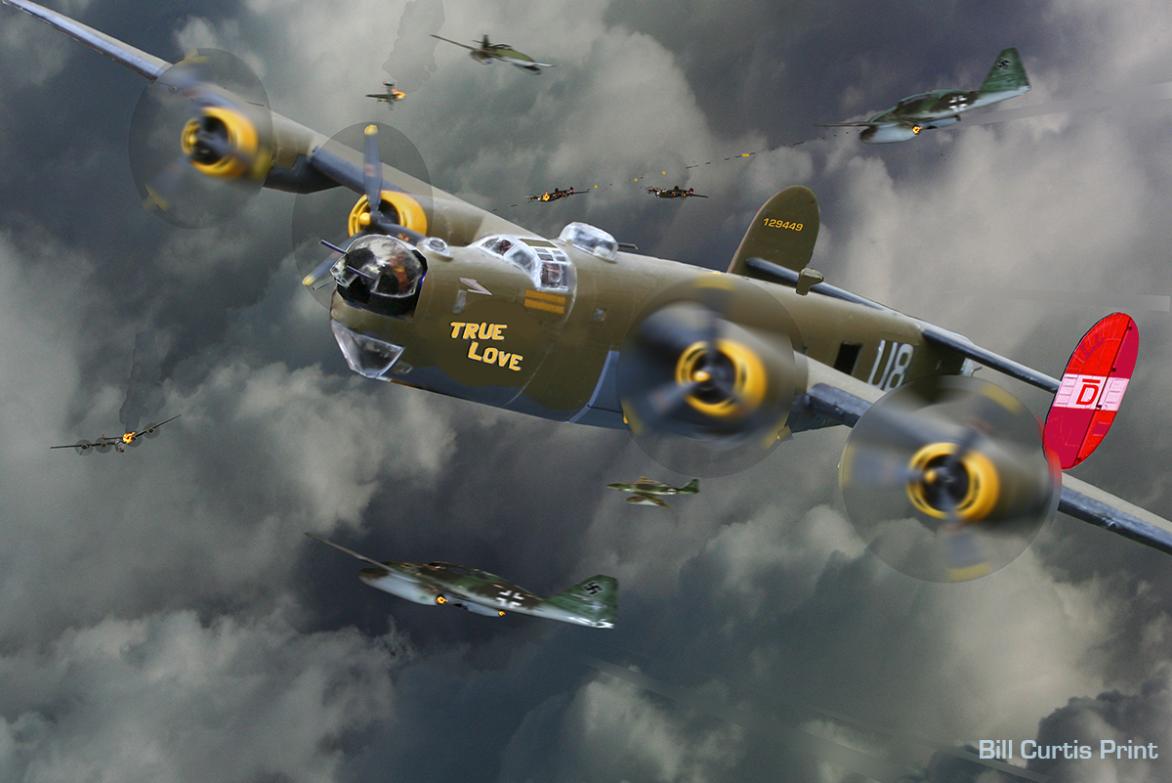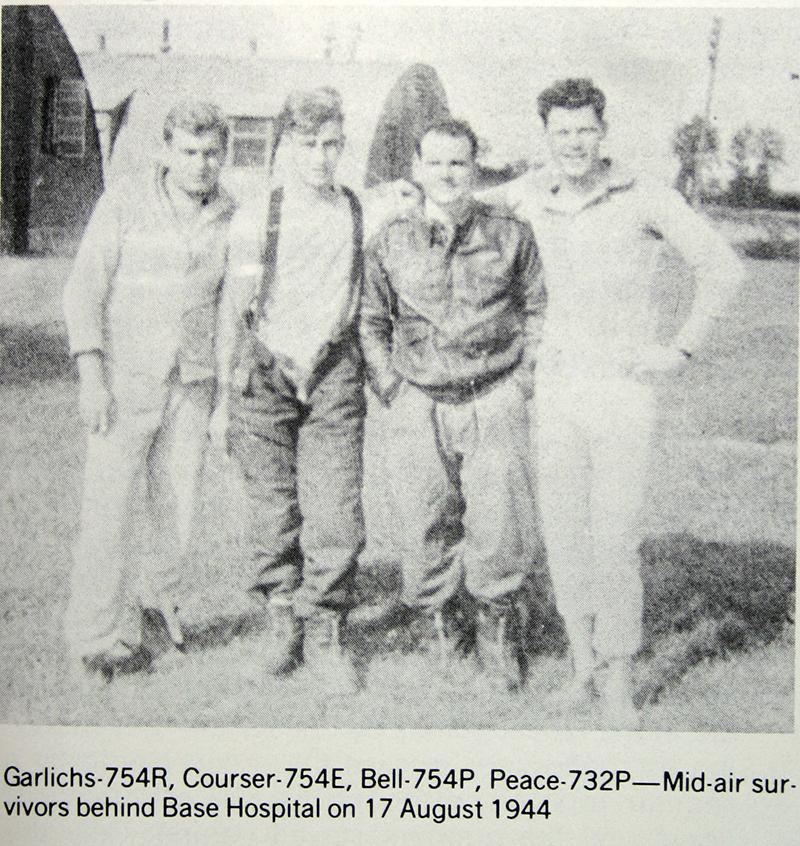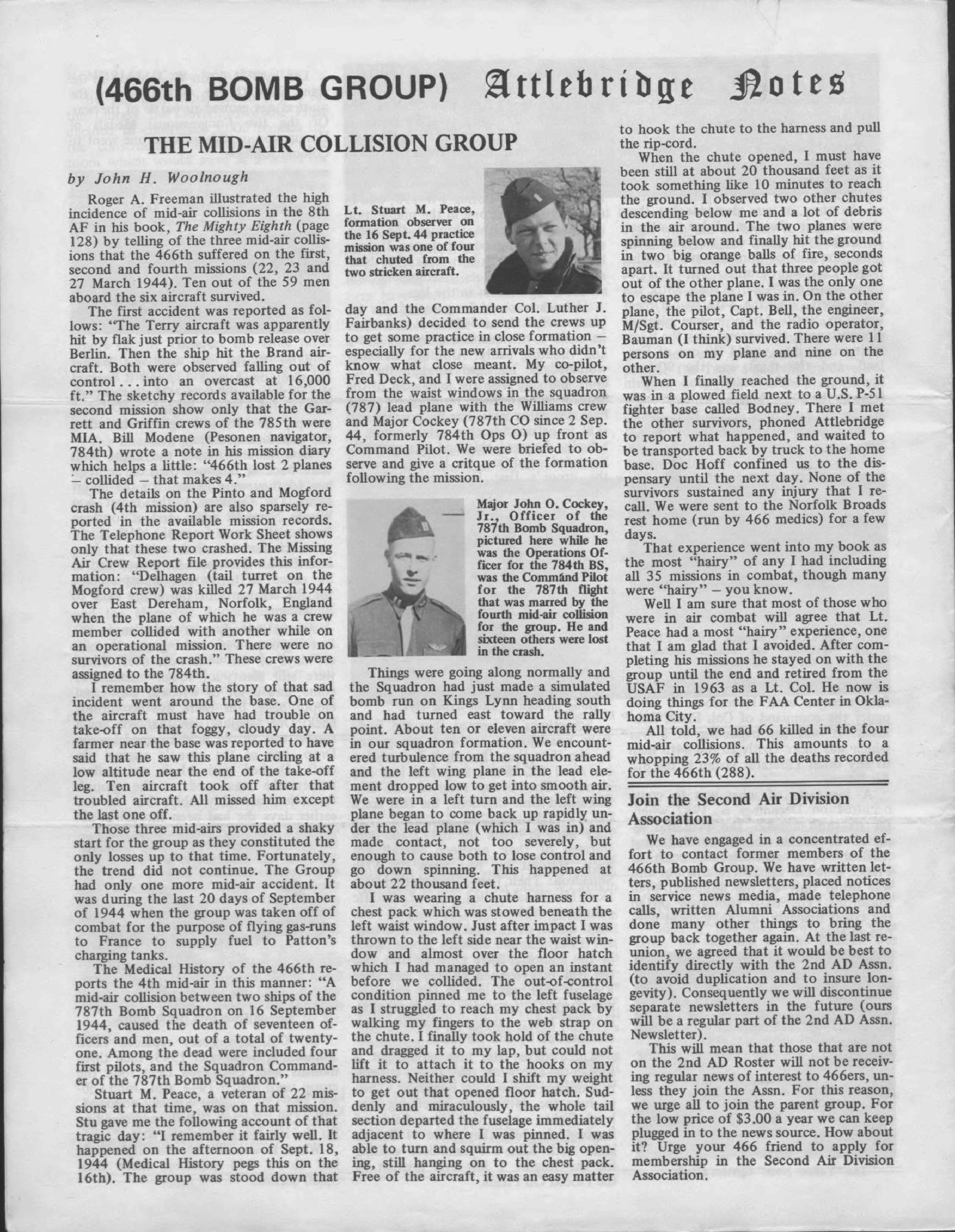466th History
August 15, 1944 - Needless Loss

August 15th was a tragic day for the 466th when four aircraft were shot down while returning from what had been a fairly uneventful bombing mission. Adding to the tragedy was the fact that it was totally avoidable. The target was VECHTA Airfield in Germany and the bomb run ran very smoothly. P-51'a provided cover going and coming back. Aircrews were told to watch out for the new jet assisted German MT -163 fighters. On the return flight over the Netherlands, 7 aircraft broke off to join another formation. Skies were overcast and cover was good. Flying formation was not as tight as recommended and the Squadron Commander broke radio silence to tell his pilots to tighten up their formation. Within three minutes of the radio message, the 7 plane squadron was hit by ME 109's and within 30 seconds four Aircraft were shot out of the sky. Aircraft that were shot down were : "True Love" (Archer Crew) "No Name 517 H" (Greenwood Crew) "Ramblin Wreck" (Harrington Crew) "Lady Lightning" (Suchiu Crew). Total KIA - 19, POW - 18 and Evadees - 3.
August 15, 1944 ROLL OF HONOR
"TRUE LOVE"
JOHN S. ARCHER JR. (P) THOMAS L BELL (CP)
NORMAN PECK (N) EDWARD B. PHILO (E)
ROBERT J. LEHMAN (RWG)
"42-9517" (GREENWOOD CREW)
HARRY E. HASEMANN (CP) TERENCE H. CROWLEY (N)
FRANK KAYDEN (E) DALE R. ESTLE (RWG)
GERALD D. BOLES (TG)
"LADY LIGHTNING"
JOHN SUCHIU (P) LOWELL D. STILES (BTG)
ROBERT ABBOTT (RWG) JEROME R. SAMBURG (LWG)
"RAMBLIN WRECK" HARRINGTON CREW"
TICE L. JONES (E) LOUIS PALERMO
WILLIAM M. JULIAN JR. (LWG) CHESTER ZYB (TG)
September 16, 1944
17 lost on Practice Mission
over England
Practice Mission over England
Its tragic when air crews are lost in combat, but when aircrews are lost on a practice mission, it adds a sense of frustration to the grief and loss.
The 466th suffered such a tragic loss on September 16, 1944. In September of 1944, combat missions were suspended for the 466th and the airplanes were rigged to fly tanks of gasoline to France for General Patton's Tank Corps. To keep crews sharp, they flew practice missions over imaginary targets in England.
From Attlebridge Notes, Dick Baynes recorded: “'(I) flew as instructor pilot in position #2. Saw #1 and #3 collide in formation.' John Blumenstock (Pilot-Crew #654 adds: 'I can only remember (a plane) up too high and knocked off his horizontal and both vertical stabilizers. I remember seeing the entire assembly, still intact as if someone had unbolted it from the top of the fuselage, flying off the aircraft.'
Francis L. Bell and his crew #754 (only seven of the crew were flying on the mission) were flying in the #3 position off of the left wing of the lead ship. Elmore Cave, co-pilot on this new crew was doing most of the flying as the action was on his side. Reports indicate that due to turbulence, the plane dropped down. It appears Cave recovered too quickly striking the lead ship. Capt. Bell reported:
'I simply could not respond quickly enough to salvage the situation. (After the collision) the controls indicated that our aircraft had lost its tail or control cables since the controls to the tail would not repsond and the aircraft was in a flat spin. I pushed the bailout button. Elmore did not respond, so I got out of my seat and forced him out of his seat. Then the wild gyrations forced me to the front of the cockpit and against the throttles. The violent surge of the aircraft threw me to the floor and I had to crawl by brute strength to the bomb bay. My co-pilot was standing over the opened bomb bay doors but would not bail out. I had to kick him out. . . he didn't survive. I don't know why.. . So I jumped and pulled on the rip cord (back pack) at least nine times without success. It appeared for an eternity that my parachute would not open. The ground kept coming closer and closer. After a desperation pull after a free fall of 15,00 feet or more it finally opened.'
The combat seasoned Williams Crew #736 were leading the formation. They had Major John O.Cockey, (the new CO of the 787th BS). John was the command pilot for this flight. Also on board were several pilots from other crews as observers. Lt. Stuart M. Peace was one of the passengers in the lead ship and here is his story:
'The Group Commander decided to send the crews up to practice close formation- especially for the new arrivals who didn't know what close meant. My co-pilot, Fred Deck, and I were assigned to observe from the waist windows in the lead plane.... We were briefed to observe and give critique of the formation following the mission.
Things were going along normally and the formation had just made a simulated bomb run on Kings Lynn heading south and had turned east toward the Rally Point. About ten or eleven aircraft were in our squadron formation. We encountered turbulence from the squadron ahead and the left wing plane in the the lead element dropped low... We were in a left turn and the left lead plane began to come back up rapidly under the lead plane (which I was in) and made contact, not too severely, but enough to cause both to lose control and go down spinning. This happened about 22,000 feet.
I was wearing a chute harness for a chest pack which was stowed below the left waist window. Just after impact I was thrown to the left side near the waist window and almost over the floor hatch which I had managed to open an instant before we collided. The out-of control condition pinned me to the left fuselage as I struggled to reach my chest pack by walking my fingers to the web strap on the chute. I finally took hold of the chute and dragged it to my lap but could not lift it to attach it to the hooks of my harness. Neither could I shift my weight to get out that open floor hatch.
Suddenly and miraculously , the whole tail section departed the fuselage immediately adjacent to where I was pinned. I was able to turn and squirm out the big opening still hanging on to the chest pack. Free of the aircraft it was an easy matter to hook the chute to the harness and pull the rip-cord.
I must have been still at about 20,000 feet as it took something like ten minutes to reach the ground. I observed two other chutes descending below me and a lot of debris in the air. The two planes were spinning below and finally hit the ground in two big orange balls of fire, seconds apart. It turned out three people got out of that other plane. I was the only one to escape the plane I was in.'”
There were 17 crewmembers KIA: 1 CO 3 senior pilots, 3 co-pilots, 2 navigators, 1 Bombardier, 1 Flight Engineer, Four gunners, 1 Radio Operator, 4 Observers.
In 2013 two 466th Veterans who witnessed this mid-air event first-hand recalled vivid memories of the horrific event in an interview. James Russell was co-pilot of the #2 aircraft with Dick Baynes standing between him and pilot Harold Anderson. James recalls: “The number 1 plane had the Squadron Commander, named “Cocky”, The number two plane was our plane (positioned on the left wing of the lead plane)- the Anderson plane and the number 3 plane was Bell (on the #1 Aircraft's Right wing) and all three planes were in the 787th Squadron. When we got through with the bombing run, they made a turn off the bombing run and headed back to base. There was a squadron right in front of us that turned a little sharper than we did and when we turned right behind them (the other squadron) we got into extreme turbulence and the Anderson plane being on the right side... were the first ones to feel the turbulence... that kept you from having lift, and when (that happened), it caused the plane to veer to the right very abruptly. The lead plane a second or two after us had the same effect- he veered to the right and the third plane two or three seconds later (BELL) had the same thing and also went to the right. The number three plane came over behind the number one plane and then came up under him. And when he came up under him, he knocked the tail off … causing them to flip (motions forward) ..and there was the matter of trying to get out. One got out of one plane and three out of the other. In addition to having 10 men (on each crew) which was usual, they had some extra people on there to see what was going on and they had some other pilots that went down with it- and some other navigators. I've thought it over for 65 or 70 years and I've come to the conclusion that the lead plane was using auto-pilot and the auto pilot is much quicker and stronger than a person handling it manually. And my conclusion is I was flying the plane in the number two position and when the wing dropped, I alowed it to drop to get away. And I got away from the rest of them. I was out there 60 or 75 feet in the clear. In the lead plane when the wing dropped the autopilot straightened him back up right quick. The other plane didn't have autopilot on, which you can't have on and fly in formation. The second plane could not react quick enough and they ran together.”
The late Herb Leopold was navigator on the Bridger's Crew and their aircraft was immediately behind the number 2 plane. He had an unobstructed view of the whole event. He recalled “I could see the one on the right (#3) turning this way (indicating right) and the one on the left (#1)wasn't moving at all; it was moving forward but it wasn't turning at all and I figured these tails are going to catch. I didn't have time to call my pilot-the only way to get communication out was for me to get my pilot on the radio and then he would have to radio to the other pilot; it just wouldn't work. The next thing I knew the empanages (Tail sections) were flying off both airplanes.
As I saw these airplanes coming together I figured something's wrong here. Because one guy was turning right and one was going straight- that's why the tails caught. It was a terrible thing and ther was a young very capable Major,...(Cockey) and he was killed in that thing.”
Airmen lost on September 16, 1947:
John O Cockey Jr. 787th CO
Archibald Williams Crew 736 Pilot
Ernest H. Vickers 736 Co-Pilot
Leroy F. Hurst 736 Bombardier
Edward L. Stutzman 736 Navigator
Phillip Hudson 736 Flight Engineer
Joseph Mazure 736 Radio Operator
George Goodhand 736 Gunner
Frederick J.Deck Jr. 732 Co-Pilot Observer
Elmore Cave Jr. 754 Co-Pilot
Robert F. Lindenmuth 754 Navigator
George M Yarbrough 754 Gunner
Jake J. Win 754 Gunner
Walter M. Bowen 668 Pilot Observer
Paul Dickerman 752 Pilot Observer
Seaton T. Douglas 753 Navigator Observer
Unknown Person Observer

Survivors of September 16th mid-air collision

SI LIBERMAN ARTICLE
SI LIBERMAN - Radio Operator on Richard Lester Crew #790 wrote this article for the Palm Beach Post in 1999

|
The_Palm_Beach_Post_Sat__Nov_13__1999_.pdf Size : 373.259 Kb Type : pdf |
William Terry Crew #612 see News Page 2